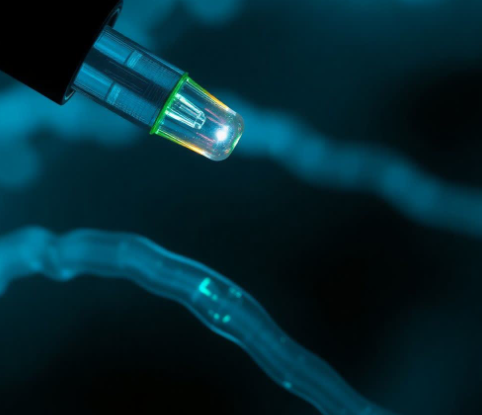"Solving Rapid Test Sensitivity: New Bioluminescent Diagnostic Detects Low Viral Counts Accurately"
Lighting Up Diagnostics:
(Source: C&EN, by Helen Alberts, Special to C&EN)
Introduction: The Persistent Challenge of Accurate Point-of-Care Diagnostics
The global landscape of infectious disease management has been profoundly shaped by recent health crises, most notably the COVID-19 pandemic, which spurred a rapid proliferation of point-of-care diagnostic tests. While these rapid tests offer the promise of quick results and decentralized testing, a significant limitation has persisted: their often-limited accuracy, particularly in crucial scenarios. "One major problem with almost all of these rapid tests is the sensitivity and specificity of these assays, especially when you're dealing with samples with a clinically relevant, low amount of the target virus," explains Hadi Shafiee, whose team at Harvard Medical School is dedicated to developing advanced diagnostic tools.
In a significant stride forward, Shafiee's group has now unveiled an innovative, user-friendly bioluminescent diagnostic test that demonstrates remarkably high accuracy in detecting multiple viruses from blood serum samples. Published in Nature Biomedical Engineering (DOI: 10.1038/s41551-025-01405-9), this development could revolutionize rapid disease detection, especially in resource-limited settings.
Bioluminescent Diagnostic Detects Low Viral Counts Accurately
Beyond Conventional Bioluminescence: The LUCAS Assay's Enhanced Power
The concept of utilizing bioluminescent proteins, such as the firefly luciferase commonly used in diagnostic tests, is not new. These natural light-emitting molecules provide a visual signal for detection. However, the true innovation lies in the Harvard team's newly developed system: the Luminescence Cascade–Based Sensor (LUCAS) assay. This novel assay has achieved a profound enhancement over existing bioluminescent tests, producing a signal that is not only significantly stronger but also lasts an impressive eight times longer.
The key to this amplified and sustained signal lies in an ingenious modification to the bioluminescent reaction. Shafiee's team achieved this by introducing an intermediate enzyme, β-galactosidase, which is linked to a target antibody specific to the virus. This intermediate enzyme then reacts with the luciferase in a carefully orchestrated sequence, creating an enzyme cascade. This cascade results in a continuous and robust light signal that persists for at least an hour, providing ample time for accurate detection and analysis.
Protein engineer Maarten Merkx from Eindhoven University of Technology, who was not involved in the study, lauded this approach, stating, "The 500-fold increase in signal is significant because I think the principle that is used is really interesting." Merkx further emphasized, "It addresses a problem that luciferases sometimes have, which is that they don’t generate a lot of photons." The LUCAS assay effectively overcomes this inherent limitation of traditional luciferase-based systems.
Exceptional Accuracy and User-Friendliness: A Game Changer for Point-of-Care
The practical performance of the LUCAS assay proved exceptional. The system demonstrated its ability to detect several critical viruses—SARS-CoV-2, HIV, and hepatitis B and C in serum with a high degree of accuracy in under 25 minutes. Crucially, these impressive results were obtained even when the test was administered by non-experts, highlighting its potential for widespread, decentralized use outside of specialized laboratories.
A head-to-head comparison with currently available HIV tests provided compelling evidence of LUCAS's superior performance. When tested on samples with low viral counts, a scenario where traditional rapid tests often falter, the LUCAS system achieved a remarkable 96% accuracy rate. In contrast, the competing tests yielded accuracy rates ranging from 74% to 82%, underscoring the LUCAS assay's enhanced sensitivity and specificity for clinically relevant low viral loads.
To further enhance usability and accessibility, the research team developed a complete, integrated system. This includes an automated microfluidic cartridge that handles sample processing and is controlled via a user-friendly smartphone application. A simple-to-use electronic sample reader completes the setup. The estimated costs for this innovative system are remarkably low: under $3 for each cartridge and less than $90 for the reader, making it an economically viable option for broad deployment.
Bioluminescent Diagnostic Detects Low Viral Counts Accurately
Future Outlook and Remaining Challenges
Shafiee expresses significant optimism about the technology's potential impact, particularly in underserved communities globally, where access to sophisticated diagnostic infrastructure is limited. "There is huge potential for something like that in underserved communities," he affirmed, while acknowledging that the technology is still in its early developmental stages.
Merkx echoed the promise of the test but also raised a critical practical concern for widespread point-of-care applications: "My main concern if you really want to use these devices in remote areas is the stability of the components... especially if you think about point-of-care applications where you'd like to have long-term stability and storage of your solutions." Ensuring the robustness and shelf-life of the reagents in diverse environmental conditions will be crucial for the system's successful implementation in remote or challenging settings.
Looking ahead, the researchers are focused on expanding the utility of the LUCAS technology. They plan to test its effectiveness with other types of patient samples, including saliva and urine. Successful validation with these less invasive sample types would significantly simplify the testing process, making it even more convenient for widespread adoption. Additionally, the team intends to explore the assay's capability to detect a broader range of other infectious diseases, further solidifying its role as a versatile and powerful diagnostic tool for global health.
Labels: "Solving Rapid Test Sensitivity: New Bioluminescent Diagnostic Detects Low Viral Counts Accurately"



